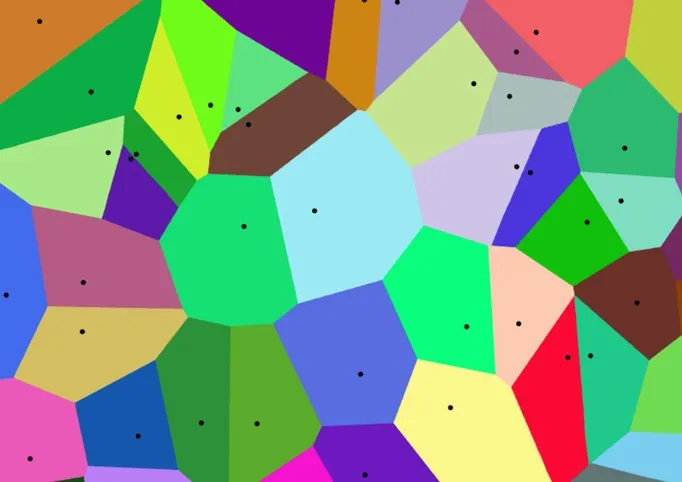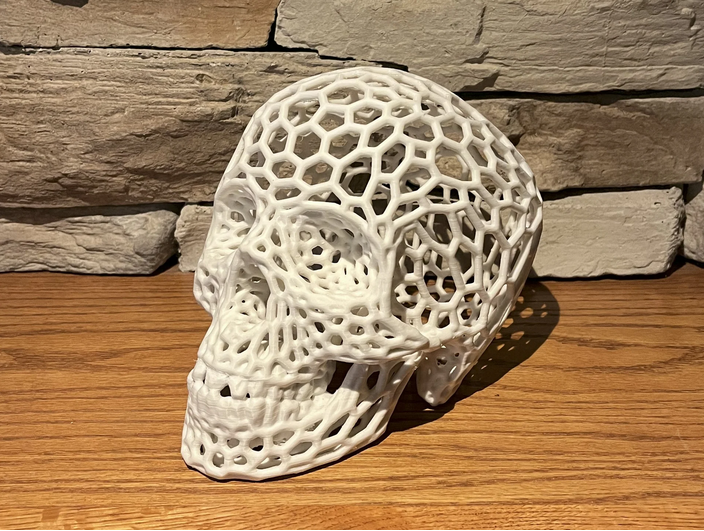For my final project, I would like to explore designs using Voronoi patterns. Voronoi patterns are a type of tessellation pattern where a number of points scattered on a plane subdivide it in exactly n cells enclosing a portion of the plane that is closest to each point. Each cell in a Voronoi pattern surrounds a “seed” point, and everything inside that cell is closer to its own seed point than to any other seed point. The pattern can be found in nature, such as in cells, mud cracks, bubbles, leaf structures, etc.
I like the appearance of Voronoi patterns and have observed them being used for architecture designs, furniture, art, and even on lamp shades, and other objects. The appearance of this pattern style is in contrast to the Bravais lattices in its seemingly arbitrary geometric distribution.
For my deliverables I would like to integrate as many of the concepts we’ve worked with in the course, such as parametric designs, tiling, and data physicalization as much as I can. I want to attempt to extend this design pattern to 3D objects, and if I can, I would like to make a large scale print of one of my models.
For this project, I am going to be working alone. I am hoping to have “printable” 2D objects within the next 1 week, and be ready to start extending the patterns in 3D objects in ~2 weeks.
I have been reading from the following links, where the Voronoi cells are explained in depth. The websites describe the nature of the cells, such as their geometry, topological aspects, distribution, and other properties.
https://pubs.aip.org/aapt/ajp/article/90/6/469/2820132/Voronoi-cell-analysis-The-shapes-of-particle
https://builtin.com/data-science/voronoi-diagram
Samples of Voronoi patterns:



Update: November 12, 2024
After reviewing some very useful feedback from Dr. Buechley, I now see a clearer path of what I want to do with my project. I am still going to be attempting to generate objects with the Voronoi patterns described in my initial post, though now in a more rigorous and structured scheme.
Regarding my update, I happen to have dozens of houseplants, and that comes with several time consuming tasks of maintenance and upkeep. One very important task, and probably the most time consuming, is to water every single plant. My problem arises from having so many plants with different sized pots, soil types, water need, as well as individual pot location within my house (light, temperature, air circulation). I don’t currently maintain a tracking system or schedule to water my plants; I kind of eyeball them and use “water days” where I water all the pots the same day. As mentioned before, that is not ideal due to different needs for each plant. My idea now involves adapting the RFID tag system described in Scott Hudson’s paper An Upcycled IoT: Building tomorrow’s IoT out of today’s household possessions (it can be found in this link: https://dl.acm.org/doi/10.1145/3466872). In the paper, Scott and his colleagues described the use of RFID tags to keep track of household chores and other things, like whether the cat has been fed that day. What I want to attempt is to use a similar system to keep track of whether I’ve watered each individual plant.
The system will consist of using RFID tags, one per pot, with individual identification numbers. Using an RFID reading module attached to a micro-controller, each time an individual pot is watered will create a log entry in the micro-controller with a time stamp of the event. The entry will be generated by the modules proximity to any individual tag. After collecting data for a given day, the resulting file will be dumped into my laptop to add to a calendar schedule. This system will allow me to keep track of when a particular plant needs water as deduced from the schedule. This way I will not need to dedicate a day to water every single pot, a task that takes me around 3 hours. Now I will be able to water in shorter sessions.
Deliverables
Initially, I will use my orchids as a small subset of plants to work on. I am going to make a set of pots for my orchids using the Voronoi pattern. This pattern is Ideal for orchids as they have special needs: they don’t like to have their roots in soil or soaked with water. The Voronoi pattern will allow air circulation while preserving enough structural integrity to hold the root media, as well as adding visual appeal. I will make 3 pots of the appropriate scale for my plants.
November 13: Initial procurement of components and supplies. I have identified the components I will need for my project and the first shipment will arrive 11/13. This shipment includes an RC522 RFID reader/writer module, a 10 pack of 1 kilobyte 13.56 MHz RFID tags, an Arduino UNO R3 micro-controller, an RTC data logger module, and other miscellaneous wires and supplies.
November 16-17: Initial prototyping of Voronoi surface morphs. I have done some preliminary research regarding applying Voronoi patterns on to surfaces. With the recent work done in the tiling project, I am confident that I can start making small-scale prototype orchid pots by Saturday 11/16. I will be applying what we saw in previous assignments such as parametric vessel design to come up with my models.
November 18-22: Begin setup, testing of RFID hardware. By this stage I hope to start working with the micro-controller and related hardware. I will start by adding the libraries required to make the devices work. I will then develop the required programs for the event logging feature. Then during this time I hope to start testing with reading/writing to the tags.
November 23-24: Full scale orchid pots. By this stage, I should be able to 3D print full scale models of my orchid pots. As mentioned before, I will start by making a set of 3 pots. If time permits, I will make more or maybe I will make some saucers to go with the pots. For my full scale final prints I decided to try using TPU filament for the added flexibility. I will report back on the results and observations I make regarding TPU.
November 25 on: Putting it all together. At this stage, I should be working on integrating all the components into the system. Each pot will receive a tag with a unique identifier. The micro-controller should be set up with all the required modules, and I should have tested it separately by this point, so integrating it into the system should be smooth. Once integrated, I will begin testing the completed system. I still have to decide how to integrate it into either some kind of add-on to my watering can, or it’s own thing with a custom printed housing. I will report back on that as soon as I figure out the best way to approach this.
Future work: Expanding the system. Assuming things go as planned, I would like to eventually implement the tag system with all my plants. Depending on the success I find with the initial small scale project I will decide whether to expand the implementation or leave it at that.
Hi German,
I have never heard of this technique and i never knew the patterns of the leafs and cells have this pattern technique. I cant wait to see your design, they are going to look very appealing.
Hi Alan, Thank you for your comment. The technique is relatively new to me as well. I had read about it before when I was a mechanical engineering student. It’s indeed interesting how this pattern is found in nature.
Hey German, you chose an interesting pattern technique and it’s cool since I plan on using a different type of pattern creation, that’s also found a lot in nature, in my final project. I think there’s a lot of space to mess around and be creative with your final prints and I can’t wait to see how they turn out.
Hi Luka, thank you for commenting on my post. I saw your post after I made mine and found it to be interesting. There are many different patterns found in the natural world and I think they must be efficient or beneficial in some way, otherwise why would these patterns be so prevalent, right?
Hey German,
I like the idea of using Voronoi patterns in your prints. I feel like there are many directions you could take this in and I can’t wait to see what your final product looks like! I saw that you mentioned you’d be trying to implement parametric designs, tiling, and data physicalization when it comes to your prints. Will you have multiple prints featuring each aspect we covered in class or will there be some blending into one print? Also how large do you plan on making your biggest model?
Hi Ryan, thank you for your comments. I am hoping to use the patterns I described in as many ways as I can, for example on surfaces, solids, and maybe some functional 3D objects. For my largest print I want to max out the volume of my printer which is about 8x8x10 inches.